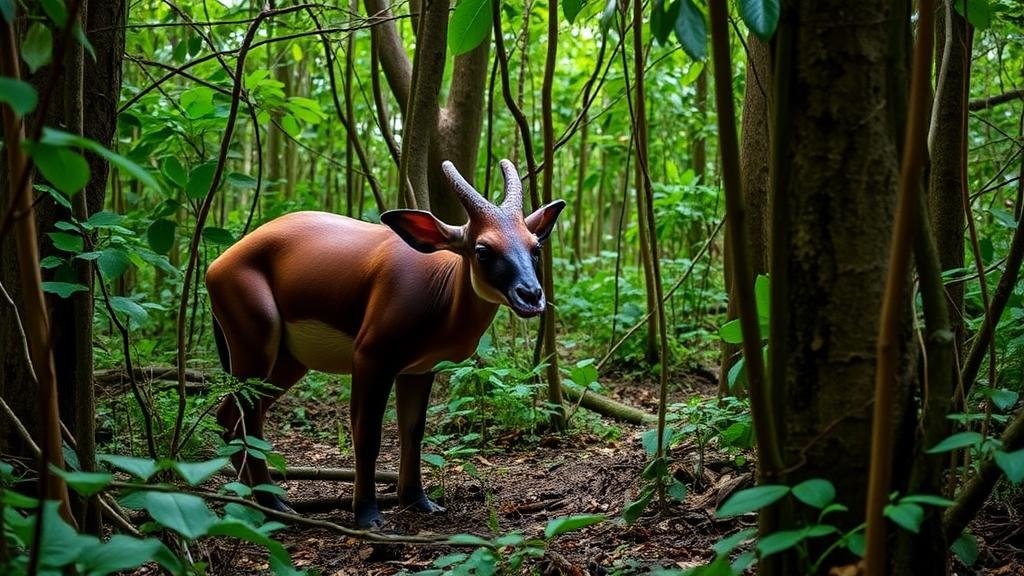Searching for rare okapis in the dense Ituri Forest of the Congo.
Searching for Rare Okapis in the Dense Ituri Forest of the Congo
The Ituri Forest, located in the northeastern region of the Democratic Republic of the Congo (DRC), is a unique and biodiverse ecosystem. This rainforest, which spans over 63,000 square kilometers, is not only home to a myriad of plant and animal species, but it also harbors one of the world’s most elusive animals–the okapi. Searching for these rare creatures in such a dense environment presents challenges and rewards that intrigue scientists, conservationists, and wildlife enthusiasts alike.
Understanding the Okapi
The okapi (Okapia johnstoni) was first discovered by the Western world in 1901, though it had been known to the indigenous Mbuti people for centuries. It is a unique herbivore, often described as a giraffe-zebra hybrid, although it is more closely related to the giraffe than any equine. Adult okapis typically stand 4 to 5 feet tall at the shoulder and possess distinctive dark brown fur with striking white stripes on their legs that serve as camouflage in the dappled light of the forest.
Habitat and Behavior
Okapis predominantly inhabit the dense, humid rainforests of the Ituri Forest. They are shy and solitary creatures, often hiding in the underbrush during the day and becoming active during dusk and dawn. e behaviors add to the difficulty of spotting them in the wild.
Researchers estimate that fewer than 20,000 okapis remain in the wild, making them classified as Endangered by the International Union for Conservation of Nature (IUCN). Habitat destruction and poaching contribute to their declining numbers, underscoring the urgent need for conservation efforts.
Challenges of Locating Okapis
Searching for okapis in the Ituri Forest involves overcoming significant challenges:
- Dense Vegetation: The Ituri Forest is characterized by thick underbrush and towering trees, making visibility limited. Spotted foot trails often lead away from the designated paths.
- Elusive Behavior: Okapis are naturally cautious and will flee at the slightest hint of danger. r innate shyness can make them nearly impossible to spot, even when researchers are equipped with the latest technology.
- Weather Conditions: The forests climate can be unforgiving, with heavy rains and high humidity levels that can disrupt fieldwork and animal tracking.
Research Methods and Technology
Researchers employ various methods to locate okapis and study their behavior, including:
- Camera Traps: Strategically placed cameras equipped with motion sensors are employed to capture images of wildlife, including okapis. This non-invasive technique allows researchers to gather data on population size and distribution.
- GPS Tracking: By fitting okapis with GPS collars, scientists can track their movements and understand their home range, giving insights into their habitat preferences.
- Local Knowledge: Collaborating with local communities who have lived in the forest for generations is crucial. Their intimate knowledge of the terrain and animal behavior can significantly aid research efforts.
Conservation Efforts
Conservation initiatives for the okapi and their habitat have grown in recent years, driven by a recognition of the species plight. For example, the Okapi Conservation Project was established in the 1980s to promote the protection of the okapi within the Okapi Wildlife Reserve, a UNESCO World Heritage site. Some key components of the conservation activities include:
- Anti-Poaching Patrols: These dedicated teams work to prevent illegal hunting of okapis and other wildlife, thereby protecting these animals from further decline.
- Habitat Restoration: Efforts to restore damaged forest areas and protect against deforestation are vital for the okapis long-term survival.
- Community Engagement: Involving local populations in the conservation process helps establish sustainable practices that benefit both wildlife and human communities.
Real-World Applications and Future Directions
The search for okapis in the Ituri Forest exemplifies the intersection of wildlife research and conservation. By implementing advanced research techniques and fostering community collaboration, biologists and conservationists can develop effective strategies for preserving not only okapis but the rich biodiversity of the Ituri Forest.
Plus, as awareness of the importance of biodiversity and ecosystem health grows, engaging the global community in conservation efforts is essential. Initiatives such as eco-tourism can help raise funds and promote local economies while creating a vested interest in protecting okapis and their habitat.
Conclusion
Searching for rare okapis in the dense Ituri Forest is not merely an adventure; it is a crucial endeavor aimed at understanding and preserving one of nature’s most enigmatic creatures. As the challenges associated with their habitat continue to grow, ongoing research and community collaboration remain vital for ensuring the survival of these unique animals for generations to come.


